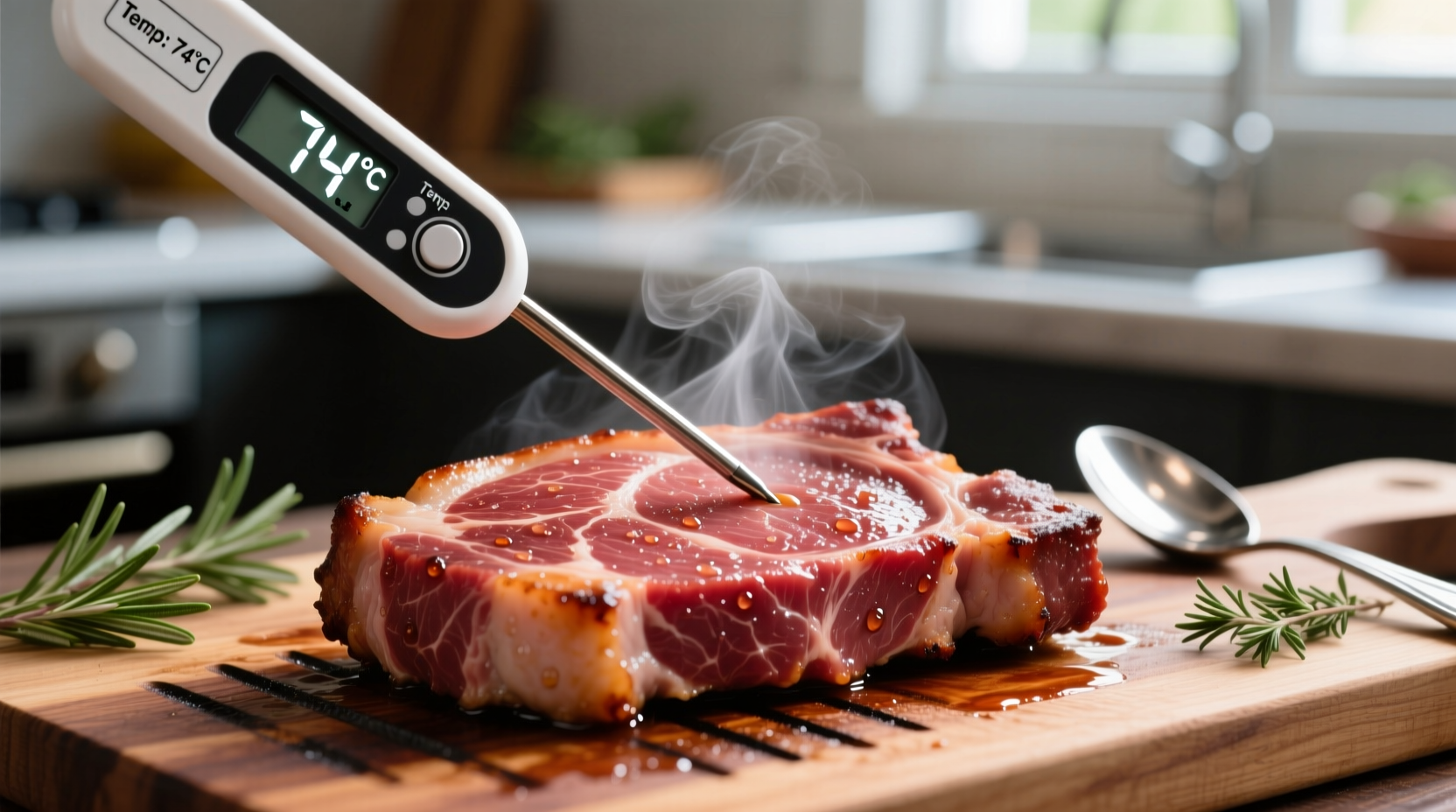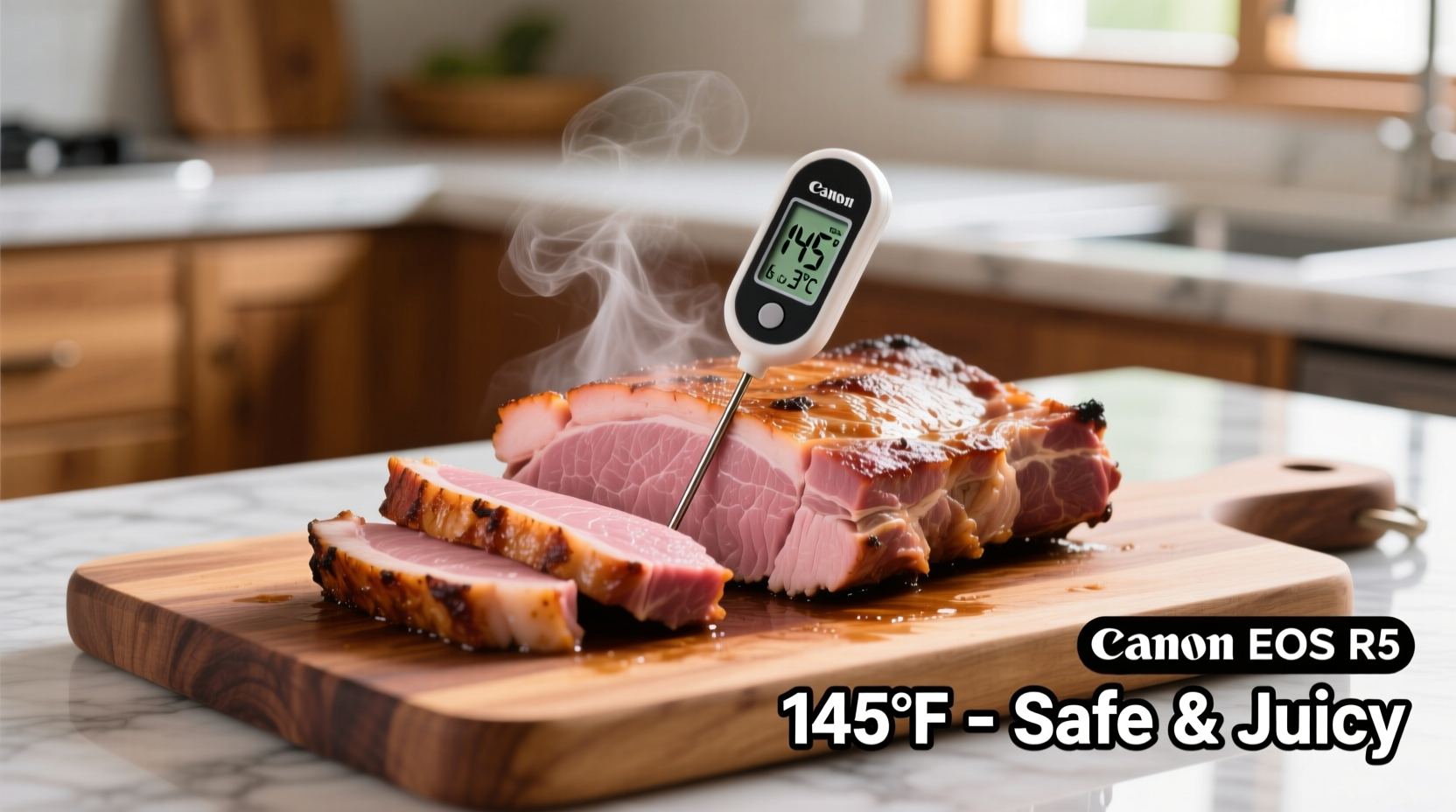The safe minimum internal temperature for cooking pork is 145°F (63°C) measured with a food thermometer, followed by a 3-minute rest period. This guideline applies to whole-muscle cuts like pork chops, roasts, and tenderloin. For ground pork, the safe temperature is 160°F (71°C) with no rest period required.
Confused about pork cooking temperatures? You're not alone. For decades, cooks were told to cook pork until it was well done and completely white. But modern farming practices and updated food safety research have changed everything. Today, properly cooked pork can be slightly pink while still being completely safe to eat. This comprehensive guide cuts through the confusion with science-based recommendations you can trust.
Why Pork Temperature Matters for Food Safety
Getting the temperature right isn't just about taste—it's critical for preventing foodborne illness. Undercooked pork can harbor pathogens like Trichinella spiralis, Salmonella, and E. coli. The USDA's Food Safety and Inspection Service (FSIS) established the current guidelines based on extensive research into pathogen destruction at specific temperatures.
When pork reaches 145°F and rests for 3 minutes, it achieves what food scientists call a "log 6.5 reduction" in Trichinella parasites—essentially eliminating the risk. This precise temperature threshold represents the point where harmful microorganisms are destroyed quickly enough to ensure safety without overcooking the meat.
Official Guidelines From Food Safety Authorities
The current standard comes from the USDA Food Safety and Inspection Service, which updated its recommendations in 2011 after reviewing scientific evidence. This change aligned with guidelines from other major food safety organizations:
- Food and Drug Administration (FDA) Food Code: 145°F for whole cuts
- Food Safety Authority of Ireland: 145-150°F for whole cuts
- CDC food safety guidelines: Consistent with USDA recommendations
| Pork Cut Type | Safe Minimum Internal Temperature | Rest Period |
|---|---|---|
| Whole cuts (chops, roasts, tenderloin) | 145°F (63°C) | 3 minutes |
| Ground pork | 160°F (71°C) | None |
| Pork ribs | 145°F (63°C) | 3 minutes |
| Pre-cooked ham (to reheat) | 140°F (60°C) | None |
How Pork Cooking Guidelines Have Evolved
Understanding the timeline of pork temperature recommendations reveals why many home cooks remain confused. Here's how official guidance has changed:
- Pre-1980s: Pork cooked to 170°F+ until completely white and well done
- 1980s-2011: USDA recommended 160°F for whole cuts
- 2011: USDA updated recommendation to 145°F with 3-minute rest
- 2016: FDA Food Code adopted 145°F standard
- Present: 145°F remains the standard across major food safety organizations
This evolution reflects improvements in pig farming that have virtually eliminated trichinosis from commercial pork in the United States. According to the Centers for Disease Control and Prevention, only 16 cases of trichinellosis were reported in the U.S. between 2011-2015, mostly from wild game rather than commercial pork.
How to Measure Pork Temperature Correctly
Knowing the right temperature is only half the battle—you must measure it properly:
- Use a reliable instant-read thermometer: Digital thermometers provide the most accurate readings. Calibrate regularly.
- Insert in the thickest part: Avoid bones, fat, or gristle which give false readings.
- Check multiple spots: Especially with irregularly shaped cuts.
- Wait for stabilization: Leave the thermometer in until the reading stops changing (about 15 seconds).
- Measure final temperature after resting: Temperature continues to rise slightly during rest time.
Many cooks make the mistake of checking temperature too early or in the wrong spot. Remember that oven or grill temperature doesn't equal internal meat temperature. Only a thermometer provides the definitive answer to what temp should pork be cooked to.
Why the 3-Minute Rest Period Matters
The rest period after reaching 145°F is a critical component of the cooking process. During this time:
- Residual heat continues to destroy pathogens
- Temperature remains at or above lethal levels for bacteria
- Juices redistribute throughout the meat
- Proteins relax, improving tenderness
Skipping the rest period means your pork hasn't actually reached the safety threshold established by food scientists. Cover the meat loosely with foil during resting to maintain temperature without continuing to cook.
Common Mistakes When Cooking Pork
Avoid these frequent errors that compromise both safety and quality:
- Guessing doneness by color: Pink color doesn't indicate undercooking in pork. Myoglobin retains pinkness even at safe temperatures.
- Not calibrating thermometers: An inaccurate thermometer gives false security.
- Resting too long: More than 10 minutes can cause temperature to drop into the danger zone.
- Cooking ground pork to 145°F: Ground meats require higher temperatures (160°F) due to increased surface area.
- Testing temperature too frequently: Each check lets heat escape, prolonging cooking time.
Special Considerations for Different Cooking Methods
Whether you're grilling, roasting, or sous vide cooking, temperature guidelines remain consistent, but technique matters:
- Grilling: Use two-zone fire to move pork away from direct heat once it approaches target temperature.
- Sous vide: Cook at 140-145°F for 1.5-4 hours depending on thickness, then sear.
- Slow cooking: Ensure pork reaches 145°F during the cooking process, not just at the end.
- Smoking: Monitor internal temperature rather than relying on time or appearance.
For precision cooking methods like sous vide, the rest period becomes less critical since the meat maintains exact temperature throughout the cooking process. However, the 145°F minimum remains essential for safety.

Trusting Temperature Over Visual Cues
Many home cooks still rely on outdated visual indicators like clear juices or complete absence of pinkness. Modern pork's appearance can be misleading:
- Pork cooked to 145°F often appears slightly pink, especially near bones
- Nitrites in cured products can maintain pink color regardless of temperature
- Some cooking methods (like smoking) can cause a pink "smoke ring" well above safe temperatures
The only reliable method to determine what temp should pork be cooked to is using a properly calibrated food thermometer. Visual cues vary too much based on pig breed, diet, cooking method, and even the pH of the meat.
Practical Tips for Perfect Pork Every Time
Put these professional techniques into practice:
- Start with quality meat: Well-marbled cuts tolerate slight temperature variations better
- Bring to room temperature: Take pork out of refrigerator 30-60 minutes before cooking
- Season generously: Salt enhances flavor and helps form a better crust
- Control cooking environment: Avoid temperature fluctuations that cause uneven cooking
- Record temperatures: Keep a log of cooking times and temperatures for different cuts
Remember that carryover cooking (the continued temperature rise after removal from heat) can add 5-10°F depending on the cut's size. Remove pork from heat when it's 5°F below your target temperature to account for this effect.
When Special Situations Require Higher Temperatures
While 145°F is the safety standard, certain circumstances might warrant cooking pork to higher temperatures:
- Immunocompromised individuals: Some healthcare providers recommend 160°F for vulnerable populations
- Commercial food service: Some establishments maintain higher standards for customer reassurance
- Wild boar or non-commercial pork: May require higher temperatures due to potential trichinosis risk
- Extended holding times: If keeping pork warm for service, higher initial temperature may be needed
These situations represent context boundaries where the standard recommendation might be adjusted based on specific risk factors, though the 145°F guideline remains scientifically valid for commercially raised pork.
Key Takeaways for Safe and Delicious Pork
Mastering pork temperatures ensures both safety and quality. Remember these essential points:
- 145°F with 3-minute rest is the safe minimum for whole cuts
- 160°F is required for ground pork products
- A reliable food thermometer is non-negotiable equipment
- Pink color doesn't indicate undercooked pork
- The rest period is a critical component of the cooking process
By following these evidence-based guidelines, you'll consistently produce pork that's not only safe to eat but also juicy, flavorful, and perfectly cooked. No more dry, overcooked pork chops or anxiety about whether your roast has reached the proper internal temperature.











 浙公网安备
33010002000092号
浙公网安备
33010002000092号 浙B2-20120091-4
浙B2-20120091-4